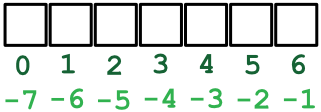4. Lists#
Today, we’ll introduce lists, our first data structure!
But first, let’s recap:
4.1. Recap#
Variables
You can think of a variable as a box in storage that contains a thing (or things). The name of the variable is a label on the box. When you use a variable in code, you get the value out of the box.
A variable can hold almost anything in Python. But there are a few simple data types that will cover most of the data we work with:
Numeric - ints and floats
String - any textual data, denoted by quotes (’’ or “”). Any character can be put into a string.
Boolean - True or False
Functions
Functions are our actors; they perform actions.
Python is a stickler for grammar, so be careful to follow the syntax for a function EXACTLY!
(this applies to all structures in Python)

4.2. Lists#
(Read WTOP Ch 6)
A list is an ordered grouping of data. So if a variable is a box, a list is a box of boxes!
enclosed in brackets with items separated by commas [A, B, C, D]
can contain any object type and types don’t need to be consistent within the list
A = [1,2, 'hello', 3.5, False]
print(A)
[1, 2, 'hello', 3.5, False]
4.2.1. Adding to lists#
You can add A SINGLE item to the end of a list with .append(item). However, this item could be a list. ‘Append’ updates the list in place.
You can concatenate two lists with +.
A.append('celery')
print(A)
[1, 2, 'hello', 3.5, False, 'celery']
B = ['DS', 256]
print(A+B)
print(A)
print(B)
[1, 2, 'hello', 3.5, False, 'celery', 'DS', 256]
[1, 2, 'hello', 3.5, False, 'celery']
['DS', 256]
A.append(B)
print(A)
[1, 2, 'hello', 3.5, False, 'celery', ['DS', 256]]
4.2.2. Length of lists#
You can get the length of a list with the function len(list)
len(A)
7
4.2.3. Indexing of lists#
The locations in a list are indexed by number, starting at 0. That is, a list starts with a zero-th entry.
Alternatively, you can index lists from the end backwards starting with -1 (the last item in a list).

new_list = ['alpha', 'beta', 'gamma', 'delta', 'epsilon', 'zeta', 'theta']
print(len(new_list))
7
new_list[-1]
'theta'
You extract a value from a list using brackets. For example, myList[5] would return the 6th entry of the list.
And you can use indexing to assign new values to items in the list.
print(new_list[5])
print(new_list[-2])
zeta
zeta
4.2.4. Slicing#
A slice is an extraction of a sub-list from a list.
You slice a list as:
new_list[startIdx:stopIdx:stepSize]
Notes:
the list will go up to but not include the stopIdx.
any of the parameters can be skipped.
Try these! First, guess what these slices will do. Then type them into your notes to check:
new_list[0:5:2]new_list[0:5]new_list[4::]new_list[:3]new_list[-3:]
new_list = [‘alpha’, ‘beta’, ‘gamma’, ‘delta’, ‘epsilon’, ‘zeta’, ‘theta]
new_list = ['alpha', 'beta', 'gamma', 'delta', 'epsilon', 'zeta', 'theta']
new_list[-1::-1]
['theta', 'zeta', 'epsilon', 'delta', 'gamma', 'beta', 'alpha']
['theta', 'zeta', 'epsilon', 'delta', 'gamma', 'beta', 'alpha']
['theta', 'zeta', 'epsilon', 'delta', 'gamma', 'beta', 'alpha']
4.2.4.1. Exercises#
Write a slice to select the colored blocks. There’s more than one way to solve each of these problems.
1.

new_list[1:5]
['beta', 'gamma', 'delta', 'epsilon']
2.

new_list[3]
'delta'
3.

new_list[1::2]
['beta', 'delta', 'zeta']
4.

new_list[-2:]
['zeta', 'theta']
5.

new_list[3:]
['delta', 'epsilon', 'zeta', 'theta']
6.

new_list[:4]
['alpha', 'beta', 'gamma', 'delta']
4.2.5. Finding an element in a list#
If a list contains an element, you can find where that element is using .index(searchItem, startIdx, endIdx).
index will only return the first instance it finds in the specified range.
my_favorite_pets = ['Ramona RIP', 'Boyd', 'MJ', 'Raylan', 'Puff', 'MJ']
my_favorite_pets.index('MJ', 3)
5
4.3. Tuples#
Tuples are just like lists EXCEPT:
They are immutable, meaning once they are created you can not change them.
They are identified by parantheses () instead of brackets [].
When functions return multiple values, those values are stored as a tuple by default.
my_tuple = (1,2,'hello')
my_eplut = my_tuple[-1::-1]
print(my_eplut)
('hello', 2, 1)
new_list[3] = 'D'
print(new_list)
['alpha', 'beta', 'gamma', 'D', 'epsilon', 'zeta', 'theta']
